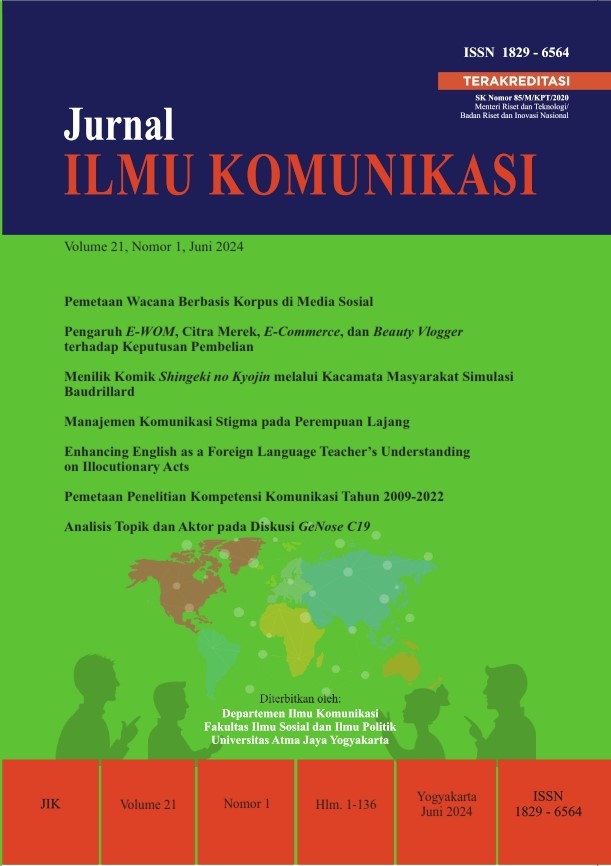Analisis Topik dan Aktor pada Diskusi GeNose C19
DOI:
https://doi.org/10.24002/jik.v21i1.7020Keywords:
Covid-19 pandemic, GeNose C19, social media, TwitterAbstract
The GeNose C19 has rised a discussion on Twitter. This study seeks to analyze and categorize topics and actors who have a significant role in spreading knowledge on the usage of GeNose C19 on Twitter between March 1st, 2020, and December 20th, 2021. The findings of this study include various topic, namely pertaining to its mechanisms and operations, superiority, marketing approval, user experience, and product comparison. Actors who played a significant role in spreading knowledge were players from the media, colleges, and government. In addition, state-owned companies play an important part in distributing technical knowledge to the public.References
Aldayel, H. K., & Azmi, A. M. (2016). Arabic tweets sentimen analysis–a hybrid scheme. Journal of Information Science, 42(6), 782-797.
Alkatiri, A. B. M., Nadiah, Z., & Nasution, A. N. S. (2020). Opini publik terhadap penerapan new normal di media sosial Twitter. CoverAge: Journal of Strategic Communication, 11(1), 19-26.
Brodjonegoro, B. P. S. (2020). Pengembangan Electronic Nose GeNose dan Uji CePAD (COVID Ag Test). <https://dinkespapuabarat.wordpress.com/wp-content/uploads/2020/12/menristekbrin-pressconf-genose-dan-cepad-28122020-rev.pdf>
Budiansyah, A. (2023). Analisis opini publik di media sosial Twitter pada diskusi kebijakan penggunaan GeNose C-19 selama pandemi 2020-2021 (Tesis Tidak Dipublikasikan). Universitas Gadjah Mada, Yogyakarta.
Chen, L., Liu, Y., Chang, Y., Wang, X., & Luo, X. (2020). Public opinion analysis of novel coronavirus from online data. Journal of Safety Science and Resilience, 1(2), 120-127.
CNNIndonesia. (2021). Ahli epidemiologi UI kritik rapid test untuk deteksi Covid-19. CNN Indonesia. <https://www.cnnindonesia.com/teknologi/20200623153641-199-516530/ahli-epidemiologi-ui-kritik-rapid-test-untuk-deteksi-covid-19>
Creswell., J. W., (2013). Research design: Pendekatan kualitatif, kuantitatif dan mixed. Yogyakarta, Indonesia: Pustaka Pelajar.
Konsorsium Riset. (2020). Konsorsium riset dan inovasi hasilkan teknologi pendeteksi Covid-19 buatan anak bangsa. Jakarta, Indonesia: Deputi Bidang Penguatan Riset dan Pengembangan Kementerian Riset dan Teknologi/Badan Riset dan Inovasi Nasional (Kemenristek/BRIN) <https://risbang.ristekbrin.go.id/publikasi/berita-kegiatan/GeNose-teknologi-pengendus-elektronik-cepat-berbiaya-rendah-dengan-sensitivitas-tinggi-pendeteksi-covid-19/>
Edo-Osagie, O., De La Iglesia, B., Lake, I., & Edeghere, O. (2020). A scoping review of the use of Twitter for public health research. Computers in Biology and Medicine, 122, 1-13.
Greenhalgh, T., Robert, G., Bate, P., Kyriakidou, O., Macfarlane, F. (2004). Diffusion of innovations in service organizations: Systematic review and recommendations. Milbank Q, 82(4)581-629.
Jacobs, L. R., & Mettler, S. (2011). Why public opinion changes: The implications for health and health policy. Journal of Health Politics, Policy and Law, 36(6), 917-933.
Junaedi, F., & Sukmono, F. G. (2020). University students behavior in searching and disseminating COVID-19 online information. Jurnal Aspikom, 5(2), 245-253.
Landwehr, P. M., Wei, W., Kowalchuck, M., & Carley, K. M. (2016). Using tweets to support disaster planning, warning and response. Safety science, 90, 33-47.
Leonita, E., & Jalinus, N. (2018). Peran media sosial dalam upaya promosi kesehatan: Tinjauan Literatur. INVOTEK: Jurnal Inovasi Vokasional Dan Teknologi, 18(2), 25-34.
Lidwina, A. (2020). Berapa rasio tes Covid-19 terhadap jumlah penduduk di Indonesia? Katadata.com. <https://databoks.katadata.co.id/datapublish/2020/04/06/berapa-rasio-tes-covid-19-terhadap-jumlah-penduduk-di-indonesia>
Liu, M., & Zhang, Y. (2018). Discursive constructions of scientific (Un) certainty about the health risks of China's air pollution: A corpus-assisted discourse study. Language & Communication, 60, 1-10.
Prambadi, G. A. (2021). Komentar adian terkait GeNose mengundang perhatian warganet. Republika.co.id. <https://news.republika.co.id/berita/qvc2tt456/komentar-adian-terkait-genose-mengundang-perhatian-warganet?>
Putri, N. A. R. (2021). Big Data Benchmark pada Google Big Query dan Elastic Search pada Data Tweets (Tesis Tidak Dipublikasikan). Universitas Gadjah Mada, Yogyakarta.
Wahyuni, H. I. (2013). Kebijakan media baru di Indonesia. Yogyakarta, Indonesia: UGM Press.
Wicaksono, R. B. (2021). Analisis sentimen pada Twitter untuk mengetahui opini terhadap vaksin nusantara (Skripsi Tidak Dipublikasikan). Universitas Gadjah Mada, Yogyakarta.
Downloads
Published
How to Cite
Issue
Section
License

This work is licensed under a Creative Commons Attribution 4.0 International License.
Jurnal ILMU KOMUNIKASI is an academic journal. As such, it is dedicated to the open exchange of information. For this reason, JIK is freely available to individuals and institutions. Authors who publish in Jurnal ILMU KOMUNIKASI will release their articles under the Creative Commons Attribution (BY) License. This license allows anyone to copy and redistribute the article in any medium or format as well as remix, transform, and build upon the material for any purpose, even commercially as long as they credit the authors for the original creation. For details of the rights authors grants users of their work, see the "human-readable summary" of the license, with a link to the full license. (Note that "you" refers to a user, not an author, in the summary)
 This work is licensed under a Creative Commons Attribution 4.0 International License.
This work is licensed under a Creative Commons Attribution 4.0 International License.














